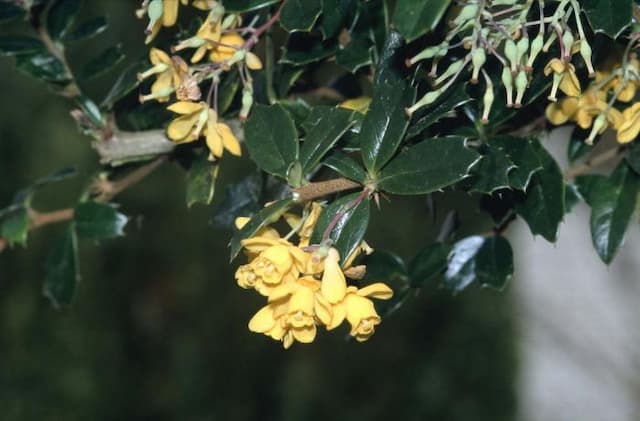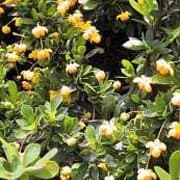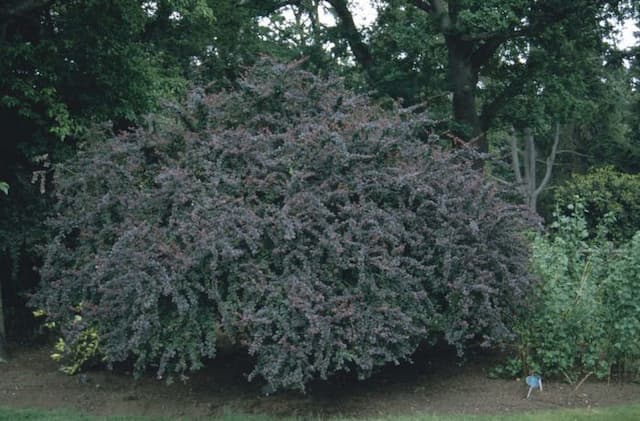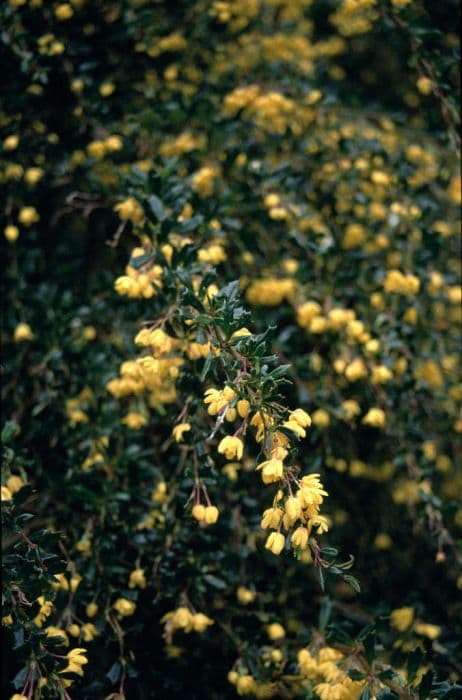Chinese Hollygrape Mahonia oiwakensis subsp. lomariifolia

ABOUT
Mahonia oiwakensis subsp. lomariifolia, most commonly known as the Chinese hollygrape, is an evergreen shrub with a distinctive and attractive appearance. This plant boasts leathery leaves that are long and divided into leaflets arranged in pairs along the central vein, much like a feather. Each leaflet is sharply toothed, resembling the spiky edge of a holly leaf, and they often have a glossy surface that can catch the light. The leaves are a deep green color, providing a lush and vibrant look throughout the year. During the flowering season, the Chinese hollygrape produces striking inflorescences comprised of many small, bright yellow flowers. These flowers are arranged in dense, upright clusters that can add a vibrant burst of color to the plant's foliage. After flowering, the plant produces blue-black berries that are attractive to birds and other wildlife. Chinese hollygrape's overall appearance is one of structured elegance, with its spiky leaves, vivid flowers, and dark berries creating a varied texture and palette that can add interest to any garden or landscape where it is planted. Its evergreen nature ensures it remains a focal point even when many other plants have lost their leaves.
About this plant
 Names
NamesFamily
Berberidaceae
Synonyms
Chingii Mahonia, Lomaria-leaved Mahonia, Holly-leaved Berberis
Common names
Berberis lomariifolia, Mahonia fortunei, Mahonia japonica.
 Toxicity
ToxicityTo humans
The common name of Mahonia oiwakensis subsp. lomariifolia is Leatherleaf Mahonia. Leatherleaf Mahonia contains alkaloids, such as berberine, which can be toxic to humans if ingested in significant quantities. Symptoms of poisoning may include nausea, vomiting, lethargy, and lowered blood pressure. Excessive consumption can lead to more severe health issues, but generally, the plant is not considered highly toxic to humans, and accidental ingestion of small amounts typically does not result in serious poisoning. However, it is always advisable to avoid eating parts of decorative plants due to potential toxicity risks.
To pets
The common name of Mahonia oiwakensis subsp. lomariifolia is Leatherleaf Mahonia. This plant can be toxic to pets, particularly dogs and cats, if consumed. The presence of alkaloids such as berberine is responsible for its toxicity. If a pet ingests Leatherleaf Mahonia, they may display symptoms such as vomiting, diarrhea, weakness, and may exhibit signs of central nervous system depression. The severity of the symptoms can depend on the amount consumed and the size of the pet. It is important to keep this plant out of reach of pets to prevent accidental ingestion and potential poisoning. If you suspect your pet has ingested this plant, contact your veterinarian or an emergency animal hospital immediately.
 Characteristics
CharacteristicsLife cycle
Perennials
Foliage type
Evergreen
Color of leaves
Green
Flower color
Yellow
Height
10 feet [3 meters]
Spread
6 feet [1.8 meters]
Plant type
Shrub
Hardiness zones
8
Native area
China
Benefits
 General Benefits
General Benefits- Landscape Ornamentation: Mahonia oiwakensis subsp. lomariifolia, commonly known as Chinese Mahonia, is often used for decorative purposes due to its striking evergreen foliage and architectural form.
- Wildlife Habitat: The plant provides shelter and nesting opportunities for birds and other wildlife within its dense, spiky leaves.
- Soil Erosion Control: The robust root system of Chinese Mahonia helps to stabilize soil and prevent erosion on slopes and in areas prone to soil displacement.
- Drought Resistance: Once established, Chinese Mahonia can tolerate periods of drought, making it suitable for xeriscaping and low-water-use gardens.
- Shade Tolerance: The plant can grow well in shaded conditions where other plants may struggle, offering greenery in darker areas of a garden.
- Winter Interest: Its vibrant, yellow blooms during late fall and winter provide color and interest in the garden during seasons when other plants may be dormant.
- Food Source for Pollinators: The flowers are a valuable nectar source for bees and other pollinating insects during the cooler months when food is scarce.
- Low Maintenance: Chinese Mahonia requires minimal care once established, making it ideal for gardeners looking for a low-maintenance landscaping option.
 Medical Properties
Medical Properties- Antibacterial activity: Mahonia oiwakensis subsp. lomariifolia has shown potential in fighting various bacterial strains.
- Antifungal properties: Extracts of the plant have been utilized for their potential in inhibiting fungal growth.
- Anti-inflammatory effects: The plant contains compounds that may help reduce inflammation.
- Antioxidant potential: The plant is believed to possess antioxidants that can scavenge free radicals.
- Hepatoprotective effects: There are indications that it may offer some protection to the liver.
 Air-purifying Qualities
Air-purifying QualitiesThis plant is not specifically known for air purifying qualities.
 Other Uses
Other Uses- Ornamental Value: Mahonia oiwakensis subsp. lomariifolia, commonly known as Holly Grape, is often planted in gardens for its attractive, holly-like evergreen foliage and bright yellow flowers.
- Wildlife Habitat: The dense foliage of Holly Grape provides shelter and nesting sites for birds and small mammals.
- Winter Garden Interest: The vibrant yellow blooms of Holly Grape can brighten up a winter garden when most other plants are dormant.
- Privacy Screening: With its dense growth habit, Holly Grape can be used as a privacy hedge to screen unsightly views or define property boundaries.
- Erosion Control: The root system of Holly Grape can help stabilize slopes and areas prone to erosion.
- Culinary Uses: Though not commonly used for culinary purposes, the berries of Holly Grape can be made into jams or jellies if properly prepared to remove any bitterness.
- Dye Production: The berries of Holly Grape may be used to produce natural dyes for fabric or artwork.
- Leather Tanning: The bark and roots, which contain berberine, can be used in the tanning of leather as a natural source of tannin.
- Photography: The distinct architecture and seasonal changes of Holly Grape make it a beautiful subject for nature photography.
- Education and Research: Holly Grape can be used for educational purposes in botanic gardens or research into the cultivation of ornamental plants suited to shady conditions.
Interesting Facts
 Feng Shui
Feng ShuiThe Mahonia, commonly known as Oregon Grape, is not specifically referenced in traditional Feng Shui practice.
 Zodiac Sign Compitability
Zodiac Sign CompitabilityThe Oregon Grape is not used in astrology practice.
 Plant Symbolism
Plant Symbolism- Resilience: Mahonia oiwakensis subsp. lomariifolia, commonly known as the Chinese Mahonia, is recognized for its hardiness and ability to thrive in challenging conditions. This reflects a symbolism of resilience and perseverance.
- Protection: With its spiny leaves, the Chinese Mahonia is often seen as a symbol of protection, guarding against negative forces and providing a safe haven.
- Healing: The plant is known to have medicinal properties, so it is symbolic of healing and the soothing of ailments, reflecting the plant’s use in traditional medicine.
 Water
WaterFor the Chinese Holly Grape, water the plant thoroughly when the top inch of soil becomes dry. This may mean watering approximately once a week, but always check the soil moisture level before watering. When watering, aim to provide enough water to moisten the soil evenly throughout the pot, which may equate to around 1-2 gallons depending on the size of the plant and the pot. During the winter months, reduce the frequency of watering as the plant's growth slows down and it requires less moisture.
 Light
LightThe Chinese Holly Grape thrives in partial shade to full sun. It is best to place the plant in a spot where it can receive at least a few hours of direct sunlight each day, while being protected from the intense midday sun. An eastern or western exposure would be ideal, offering bright indirect light that is not too harsh for the foliage.
 Temperature
TemperatureThe Chinese Holly Grape does well in a range of temperatures from 50°F to 80°F. It can tolerate a minimum temperature of around 20°F but should be protected from temperatures below this to prevent damage. The ideal temperature range for promoting healthy growth is between 60°F and 70°F. This plant is quite hardy once established but should not be exposed to extreme cold.
 Pruning
PruningPrune the Chinese Holly Grape to remove dead or damaged branches and to maintain a desirable shape. Pruning is best done in late winter or early spring before new growth begins. This timing allows the plant to heal quickly without affecting its blooming cycle. You might need to prune the plant once a year, or as needed if you notice dead wood or branches that are detracting from the plant's appearance.
 Cleaning
CleaningAs needed
 Soil
SoilChinois mahonia thrives in well-draining soil that is rich in organic matter with a pH range of slightly acidic to neutral (pH 5.5 to 7.5). The best soil mix includes equal parts of garden soil, peat moss or compost, and perlite or sand to aid drainage.
 Repotting
RepottingChinois mahonia should be repotted every 2 to 3 years, preferably during spring or fall. Younger plants tend to grow more rapidly and may need repotting more frequently, while more mature plants can be repotted less often.
 Humidity & Misting
Humidity & MistingChinois mahonia prefers moderate to high humidity levels. A humidity level ranging from 50% to 60% is ideal for this plant. It tends to thrive when the air is not too dry.
 Suitable locations
Suitable locationsIndoor
Provide bright, indirect light and maintain high humidity.
Outdoor
Plant in partial shade, protect from harsh sun and wind.
Hardiness zone
7-9 USDA
 Life cycle
Life cycleMahonia oiwakensis subsp. lomariifolia, also known as the Chinese Hollygrape, begins its life cycle as a seed, typically germinating in moist, well-drained soil in partial to full shade. Upon germination, it develops a root system and a rosette of pinnate, holly-like leaves, followed by steady stem growth. As it matures, the plant forms a multi-stemmed, upright shrub that can reach up to 10 feet tall, producing yellow flowers in dense racemes, which are highly attractive to pollinators. After pollination, usually by insects, the flowers develop into blue-black berries, which are dispersed by birds and other wildlife, facilitating the plant's propagation. Chinese Hollygrape is an evergreen, and its leaves may persist for several years before being shed and replaced with new growth. It reaches full maturity in several years and can live for a considerable time, during which it will continue to undergo seasonal flowering and fruiting cycles.
 Propogation
PropogationPropogation time
Fall to winter
The Mahonia oiwakensis subsp. lomariifolia, commonly known as Chinese holly grape, is typically propagated through semi-hardwood cuttings. The best time to take these cuttings is in summer, when new growth has matured slightly and begun to harden. To propagate, select a healthy portion of the parent plant and cut a 4 to 6 inch (10 to 15 centimeters) length just below a leaf node, where the concentration of growth hormones is higher. Remove the leaves from the lower half of the cutting to prevent excess moisture loss and potential fungal growth. Dip the cut end in rooting hormone to encourage root development, then insert the cutting into a pot filled with a mix of peat and perlite to ensure good drainage and aeration. The cutting should be kept moist, but not waterlogged, and placed in indirect light until roots have developed, which can be checked by gently tugging on the cutting after a few weeks. After roots have formed, the young plant can be transferred to a larger pot or a suitable location in the garden.









